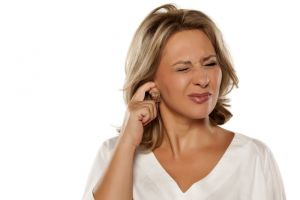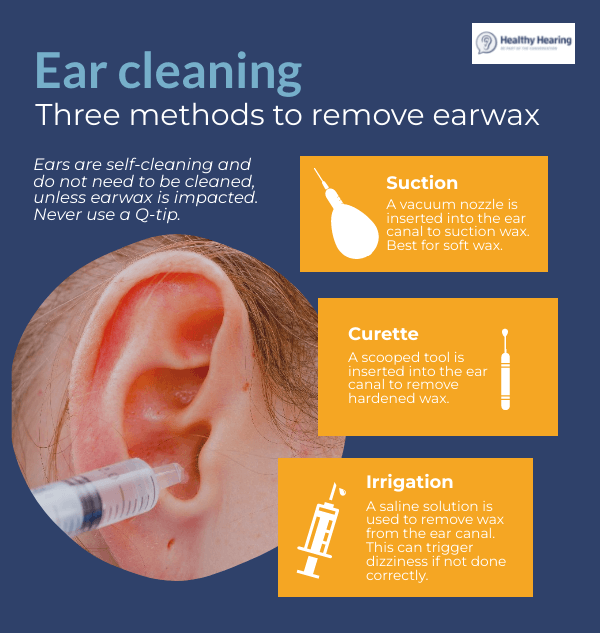|
www.HealthyHearing.com |
How to clean your ears safelyHere's what to expect if you need help removing impacted earwax
Contributed by Madeleine Burry If there’s an audiologist nearby when you approach your ear with a cotton swab, they’ll advise that you drop it. Q-tips shouldn’t be used to clean your ears (in fact, it even says so on the box). And yet: You’re far from alone if you dive in with a cotton swab after every shower. About 90 percent of people believe their ears should be cleaned, and according to one survey in England, around 68 percent of people regularly use cotton buds to do so. But for most people, ear cleanings—whether at home with a Q-tip, or in a clinic setting—simply aren’t necessary. “Generally speaking, the ear is self-cleaning and able to naturally free itself of cerumen [aka earwax] and debris,” says audiologist Amy Sarow. That said, there are some circumstances where cleaning may be merited—here’s what you need to know about when to visit a pro for an ear cleaning, and what to expect during the process.
Why some ears need professional cleaningParadoxically, one of the reasons you may need your ears cleaned out is if you have a habit of digging around with a Q-tip. Pushing that bud into your ear drives earwax into the canal, which can lead to excess earwax or an earwax blockage. Earwax is only produced in the outer third of your ear canal (that’s about the length of the first joint in your pinky), explains Audiologist Elly Pourasef, of Houston’s Memorial Hearing. “If wax starts to get impacted, it’s very, very rare that it magically crawled toward your eardrum on its own,” she says. More likely: Using a cotton swab pushed that wax deeper in your ear, from the canal to the eardrum. Other things you put in your ears—such as hearing protection, earbuds from headphones, or hearing aids—can also drive the wax further into your ear canal, Pourasef says. Chemicals like mineral oil or hydrogen peroxide will not work on wax (though peroxide can be useful if you have water trapped in your ear). Other factors can also lead to certain people having earwax buildup:
Plus, both older people and people with developmental delays are also more likely to have earwax buildup. Signs you need your ears cleanedSome of the signals that you should consider going into a clinic and getting your ears cleaned out include the following, according to the Mayo Clinic:
3 methods for professional ear cleaningThere are a few different ways that professionals can clean your ears, removing earwax and other gunk. The choice will depend on your preferences, as well as other factors. Before they get started, your hearing care provider will use an otoscope to look in your ear. “Depending on the consistency of the earwax, one or more methods may be used to remove the earwax,” Sarow says. Suction
can quickly lead to a perforated eardrum. A softening agent, known as an cerumenolytic, is usually applied to make it easier and more comfortable to remove earwax, Sarow says. “Suction will work best for soft earwax and is done by inserting a long, thin vacuum nozzle into the ear canal,” she says. You may hear squealing or crackling sounds during the process, Sarow notes. “The doctor is able to monitor the removal process visually with a microscope while underway,” Sarow notes. This is a low-risk option that works well for most people, Sarow says. Sometimes suction alone won’t do the trick—a curette may also be required (more on that below). And, it can be quite loud, “which may be uncomfortable for those who are sound sensitive,” Sarow says. A curette“If the earwax is darker in color, hand tools, such as a curette, may be used to break up or remove pieces of the debris,” Sarow explains. A curette is a spoon-shaped surgical instrument. “It is important to remain still during this process and let the clinician know if anything is causing pain or discomfort,” Sarow says. With this method of removing wax, there’s a chance that the skin will get damaged, Sarow says. This “can be particularly uncomfortable if the impacted wax is located in the bony portion of the ear canal (nearest the eardrum),” she says. Your clinician will need to be particularly careful if you have diabetes, are on blood thinners, have a weak immune system, or are HIV positive, Sarow says. People with diabetes have more fragile skin in their ear canals. IrrigationWith this tactic, water mixed with saline is used to remove wax from the ear canal. This method is a no-go for anyone with a perforated eardrum. And, it’s particularly key to get the water temperature correct. “Water that is even a few degrees warmer or cooler than body temperature can trigger dizziness for patients,” Sarow says. At some clinics or offices—like Pourasef’s—there might be a machine called an Earigator™ available to do this irrigation process. The 'ear spa' experienceThe advantage of this machine, Pourasef says, is that the water is temperature regulated. That means the water will feel “soothing” and like an “ear spa,” Pourasef says. Even more importantly: “It doesn't elicit a nauseous or vertigo response,” she says. Plus, the process is faster than other methods. Pourasef describes it as being like “power washing” and says using the Earigator cuts the time to less than a minute (versus the near hour it might take if she was using suction). You can get a sense of what to expect from irrigation in the videos Pourasef posts on her Tiktok and Instagram account. She and other audiologists have found that people find ear cleaning videos fascinating. Ear cleaning steps
ears to look for impacted earwax. Even before the clinician removes the wax from your ear, they’ll probably take a look. “First, we make sure the patient has wax in their ears,” Pourasef says. She notes that many people come in thinking they have wax and don’t—sometimes there’s simply nothing there, and sometimes there’s a bigger issue afoot, she says. Plenty of things can get stuck in our ears, including bugs and hearing aid tips. So, before any cleaning, the clinician will peer in your ears to see if it looks like there is wax. They will also likely do a tympanogram, a type of medical test, to confirm there’s no hole in the eardrum, Pourasef says. No matter which process is used to clean your ears, you can expect it to go pretty fast. “On average, an ear cleaning takes about 15 minutes,” Sarow says. And, while it may not be the most comfortable, it also shouldn’t be too burdensome. “Patients report some pressure or suctioning during the procedure,” Sarow says. How long it takes, and how uncomfortable it feels, can vary depending on your wax situation. If you’ve got an ear canal that’s totally plugged up with hardened wax, it’ll take more time to remove, Sarow says. Softer wax is usually easier to remove and a more comfortable process. You may notice a few changes after your ear cleaning, including temporary tinnitus caused by the suction-related sounds or vertigo following irrigation, Sarow says. But the best side effect you may experience is a positive one. “Many people notice that they can hear more clearly after cerumen removal,” Sarow says. Madeleine Burry
Related Help Pages:
Hearing loss Hearing aids Bluetooth Fitting Insurance & financial assistance Cleaning Repairs Used hearing aids
|
Featured clinics near me
Earzlink Hearing Care - Reynoldsburg
7668 Slate Ridge Blvd
Reynoldsburg, OH 43068

Find a clinic
We have more hearing clinic reviews than any other site!



 Madeleine Burry is a Brooklyn-based freelance writer and editor. She's written about health for several online publications, including Women's Health, Prevention, Health, Livestrong and Good Housekeeping. You can follow her on Twitter @lovelanewest.
Madeleine Burry is a Brooklyn-based freelance writer and editor. She's written about health for several online publications, including Women's Health, Prevention, Health, Livestrong and Good Housekeeping. You can follow her on Twitter @lovelanewest.